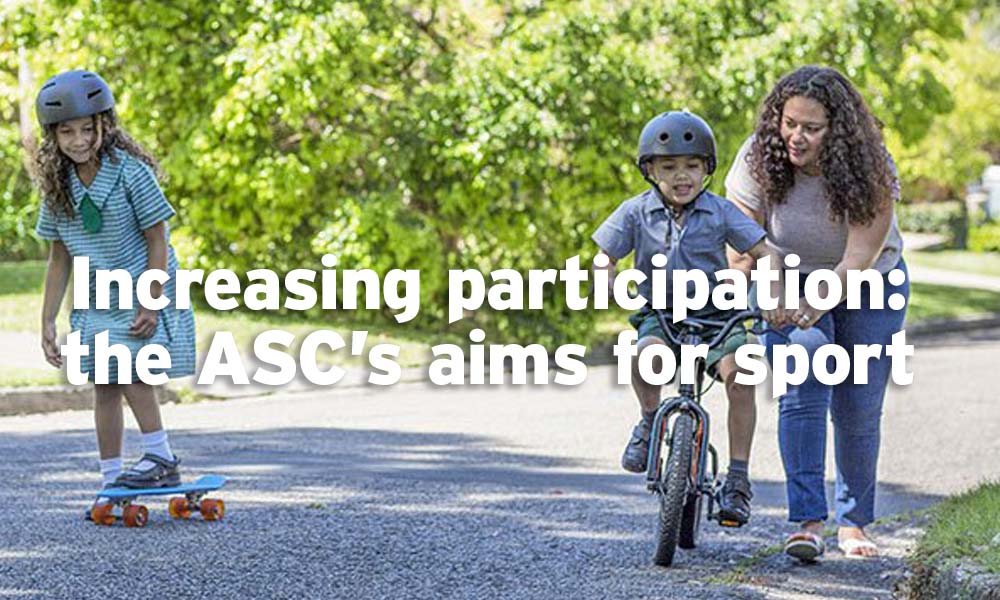[et_pb_section bb_built=”1″ admin_label=”section”][et_pb_row admin_label=”row” background_position=”top_left” background_repeat=”repeat” background_size=”initial”][et_pb_column type=”1_4″][et_pb_text background_layout=”light” use_border_color=”off” background_position=”top_left” background_repeat=”repeat” background_size=”initial” _builder_version=”3.0.93″]
There are regular signs that the CEO of the Australian Sports Commission, Kate Palmer, is doing all she can to incorporate participation initiatives into the ASC’s spending with a view to “enrich the lives of more Australians through sport and physical activity”.
[/et_pb_text][/et_pb_column][et_pb_column type=”3_4″][et_pb_text background_layout=”light” use_border_color=”off” background_position=”top_left” background_repeat=”repeat” background_size=”initial” _builder_version=”3.0.93″]
Each round of press releases from the Australian Sports Commission seems to deliver more promising news for the broader community. The latest missive reiterates the desire to help prompt Australians to be more active and for sport to be utilised for more than just glorification of the ego and the feel-good factor that comes with winning.
A day after the federal budget, the ASC has issued another press release, this time titled: “ASC welcomes funding to get Australians more active”.
The bullet points tell us about the allocation of funding that comes via the federal government’s sporting body to get the community engaged with physical activity, in the hope of having a healthy nation.
* * * * *
[/et_pb_text][/et_pb_column][/et_pb_row][et_pb_row][et_pb_column type=”4_4″][et_pb_text _builder_version=”3.0.93″ background_layout=”light” text_text_color=”#0c71c3″ box_shadow_style=”preset2″ custom_padding=”20px|20px|20px|20px” border_color_all=”#0c71c3″]
Summary of spending on sport: federal budget
- $50.4 million over four years to increase the investment in sport organisations for participation outcomes. This would include increased investment in junior sport pathways such as the national Local Sporting Champions grants program;
- $41.7 million to continue managing the Australian Government’s Sporting Schools program until the end of the 2019 calendar year;
- $29.7 million in 2018-19 for a grants program to improve local community sport infrastructure, and;
- $22.9 million over two years for a new grants program aimed at increasing the physical activity of Australians aged 65 and older.
- Palmer said: “The ASC welcomes this funding for community sport because a thriving sport system begins with a healthy, vibrant participation base.
- This funding will enable the ASC and our partner organisations to reach and enrich the lives of more Australians through sport and physical activity.
[/et_pb_text][/et_pb_column][/et_pb_row][et_pb_row][et_pb_column type=”1_4″][et_pb_text background_layout=”light” use_border_color=”off” background_position=”top_left” background_repeat=”repeat” background_size=”initial” _builder_version=”3.0.93″]
Changes to government spending on sport as outlined in the Federal Budget (above).
[/et_pb_text][/et_pb_column][et_pb_column type=”3_4″][et_pb_text background_layout=”light” use_border_color=”off” background_position=”top_left” background_repeat=”repeat” background_size=”initial” _builder_version=”3.0.93″]
* * * * *
Exactly how this affects the spend on cycling remains to be seen but it would seem that Palmer is listening to the community and recognising the need to support grassroots initiatives while, at the same time, not precluding high performance programs that have long been part of the ASC’s so-called ‘Winning Edge’ policy.
Rather, Palmer wants the two elements of sporting management to complement each other: for elite athletes to inspire others into action… and, so the theory goes, once there are more people doing sport there’ll be more elite athletes. And the cycle perpetuates with the result being a healthier, more active, more engaged sporting culture. If more wins on the international stage come because it this approach, that’s an added bonus – but victory is not the only aim even if it’s clear that the aging policy still needs endorsement as it is slowly phased out.
“The ASC, led by our high-performance arm the AIS,” concludes the release, “is continuing to work with the Australian government to inform high performance measures and funding for Australian sport into the future.”
In recent weeks there have been discussions between the ASC and cycling administrators to establish ways of altering the approach to spending and perhaps having more of a focus on participation instead the age-old quest for Olympic gold. There remains, however, a theme of endorsing expensive sporting carnivals because of the “inspiration” offered by elite athletes.
“We have seen with the recent Gold Coast Commonwealth Games,” said Palmer, “the effect that our amazing athletes can have in inspiring our nation and strengthening community spirit.”
Let’s hope that the increase in funding from the federal budget is a sign of things to come, that the government recognises that a more active society is a healthier one – and that there is a lot more to sport than winning alone. Unless you participate, it’s impossible to win. For many, just working up the gumption to be more active is the biggest challenge. But, as Palmer says, “We have a responsibility to ensure our children learn and develop through movement.”
Once they’re moving, they’ll recognise the benefits and reap the rewards. That’s a winning edge that serves the nation well.
– By Rob Arnold
[/et_pb_text][/et_pb_column][/et_pb_row][/et_pb_section]



